 |
|||||||||
|
|||||||||||||||||||
|
|
2011 Soil Nitrogen Supply Looks Low The total amount of Nitrogen that crops can expect to get from the soil in 2011 is similar to 2010, which was itself a lower than average year.
The figures, just released by GrowHow UK’s arable agronomist Allison Grundy, are taken from actual measurements made on farms that have used the GrowHow N-Min soil Nitrogen sampling service and located all around the country. The average amount of N we have measured from all samples analysed so far is 81kg/ha. However as with all averages these figures need to be viewed with caution as there are many field specific factors than can affect N levels. “There is no substitute for measuring your own fields,” she advises. Interestingly it is actually the heavier soils where the lowest amounts of soil N are being measured – an average of 70 kg N/ha, whereas in light and medium soils it is at around 85 kg N/ha. “Unlike other Nitrogen sampling methods, N-Min calculates the total amount of N that will come from the soil from the day the sample was taken until the end of the growing season,” explains Allison. “This is made up of SMN (Soil Mineral Nitrogen) and AAN (Additionally Available Nitrogen). The AAN is measured though an incubation test and is the amount of N that will mineralise from the soil between spring and harvest,” she adds. Looking at the split between SMN and AAN, around 60% of the soil available N is coming from the AAN portion this year so just 40% is actually in the soil as SMN at the time the sample was taken. “This 60:40 split looks to apply across all soil types and is very much in keeping with what ADAS has been saying about being extra careful if you are relying solely on an SMN measurement to work out how much Nitrogen to apply,” she explains. “However if we compare SMN levels with those this time last year the SMN portion is actually around 10% higher than it was then. Those very low measurements were associated with the cold snap in January and February 2010.” Once again averages can mask big differences. The lowest amount of AAN we have measured is just 3kg N/ha, the highest is 145 kg N/ha. “Low AAN figures can be caused by several factors. Fields low in organic matter will contain smaller amounts of AAN and, very productive fields where big yields are consistently achieved are also likely to result in low AAN values,” she explains. “Again it all comes down to field specific details and agronomic history.” “Don’t forget either that, whilst it has been a cold and relatively dry winter, it was a good autumn in many parts of the country. Crops that established well will have mopped up any leftover N before the cold weather hit. That’s why Nitrogen recommendations must always allow for the amount of N already in the crop,” she concludes.
|
||||||||||||||||||

|
|
||||||||||||||||||
| home | agri-services | pedigree
pen | news | dairy | beef | machinery BPS | property | organisations | site map |
|||||||||||||||||||


